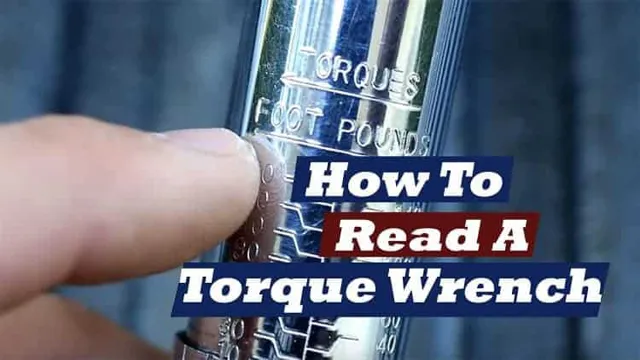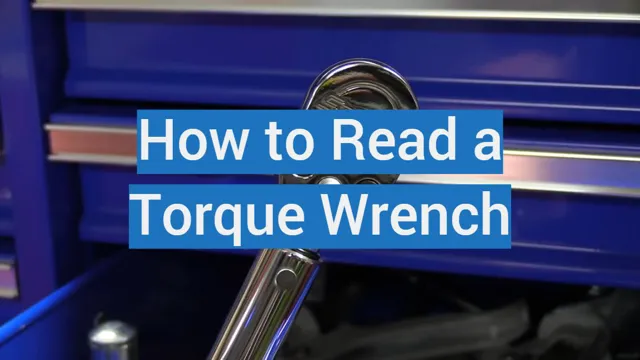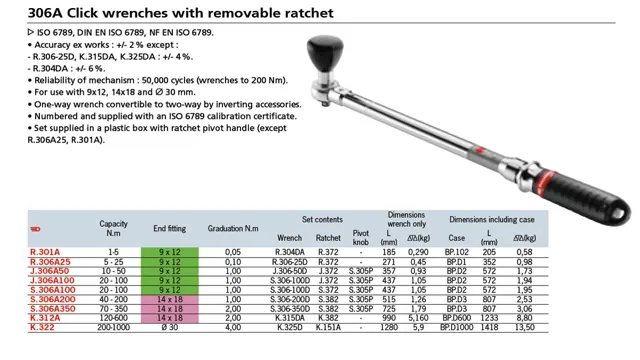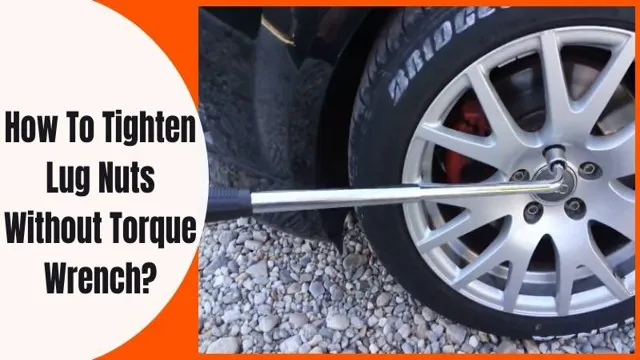How Do You Read a Torque Wrench: A Comprehensive Guide for Accurate Torque Measurements

Have you ever wondered how to use a torque wrench? It may seem intimidating at first, but reading a torque wrench is actually quite simple. Think of it like a measuring tape, but instead of measuring length, it measures force. Torque wrenches are essential tools for tightening bolts to a specific level of tension, ensuring that everything stays securely in place.
Whether you’re a mechanic, DIY enthusiast, or just someone who wants to make sure their equipment is fastened properly, learning how to read a torque wrench is a valuable skill to have. In this blog post, we’ll go over the basics of torque wrenches and give you a step-by-step guide on how to read one. So grab your torque wrench and let’s get started!
Introduction
Torque wrenches are an essential tool for mechanics and DIY enthusiasts alike. However, if you’re new to using a torque wrench, you may be wondering how to read it. Firstly, it’s crucial to note that torque wrenches measure the amount of force being applied to a bolt or nut.
The wrench will click once the set torque value has been reached, indicating that the bolt or nut has been tightened to the correct spec. When using a torque wrench, you’ll need to select a torque value based on the manufacturer’s recommendations for the specific application. Make sure to use the correct unit of measure (such as foot-pounds or Newton meters) and adjust the wrench accordingly.
Once you’ve tightened the bolt or nut and the wrench clicks, be sure to stop tightening to avoid risking damage to the fastener or the surrounding components. Remember, a torque wrench is a precision tool, and accuracy is crucial to ensure your project stays secure and safe.
Explanation of Torque Wrench
Torque wrench Introduction: When it comes to fastening bolts and nuts, accuracy and precision are crucial. For this reason, torque wrenches have become a necessary tool in the mechanic’s toolbox. A torque wrench provides the user with a precise amount of force needed for tightening or loosening bolts.
The tool typically has a handle and a ratcheting mechanism to adjust the torque setting. With a torque wrench, you can be sure that the fasteners are not too loose, which can cause vibrations and defects, or too tight, which can damage the components. In this article, we will explore the different types of torque wrenches and their applications in various fields.

The Importance of Proper Torque
Proper torque is essential to ensure the safety and reliability of any mechanical equipment or device. It refers to the force applied to tighten bolts or nuts to a certain level, using a torque wrench or other measuring tool. If the torque isn’t correctly set or applied, it can lead to several issues such as loose or overtightened bolts, which can create unsafe conditions or cause equipment failure.
This is particularly important in industries like aviation, oil and gas, and automotive, where any mistakes in torque application can lead to catastrophic consequences. Therefore, it’s crucial to use the correct torque settings and tools provided by manufacturers and follow industry standards for torque application. By doing so, we can ensure the longevity, safety, and efficiency of the equipment or device.
Reading a Torque Wrench
Have you ever wondered how to read a torque wrench? Well, let’s break it down. First, you need to set the torque wrench to the desired torque value. This can usually be done by turning the handle or dial until you reach the desired measurement.
Next, tighten the bolt until you hear or feel a click. This click indicates that you have reached the desired amount of torque. Some torque wrenches may also have a visual indicator, such as a digital display or color-coded lines, to show when the proper torque has been achieved.
It’s important to note that over-torquing or under-torquing can lead to equipment failure or personal injury, so understanding how to properly read and use a torque wrench is crucial. Happy torque wrenching!
Grip the Torque Wrench Properly
When it comes to using a torque wrench, it’s not just about setting the right amount of torque. You also need to grip the torque wrench properly to ensure accuracy and avoid potential injuries. To begin, make sure your hand is positioned correctly on the handle of the wrench and that your grip is firm but not too tight.
Next, make sure you are using the correct technique when applying force to the wrench, which involves keeping your hand and elbow straight while using your upper arm muscles to turn the handle. It’s also important to maintain a consistent grip pressure throughout the entire tightening process, and to avoid adding any unnecessary force or twisting motions. By following these tips and practicing proper torque wrench usage, you’ll be able to achieve accurate and consistent torque readings every time.
Set the Desired Torque Value
Looking to ensure that your nuts and bolts are tightened to the right torque value? Then, a torque wrench is essential! But, how do you read a torque wrench? First, set the desired torque value by adjusting the wrench’s handle, which is usually done by rotating it clockwise or counterclockwise. Make sure to consult the manufacturer’s instructions to get the correct setting for your specific job. Once you’ve set the torque wrench to the correct setting, you’re ready to go! Simply attach the wrench to the nut or bolt and start tightening until you feel a click.
The click indicates that you’ve reached the desired torque value, and you should stop immediately to avoid over-tightening. By using a torque wrench, you can be confident that you’re tightening your fasteners to the correct level, ensuring safety and preventing damage. So, next time you’re tackling a job that requires precise torque values, grab your torque wrench and set it to the right setting for a job well done.
Apply Force to the Wrench
To properly read a torque wrench, you will need to understand how to apply force to it. Torque wrenches are used to tighten bolts and nuts to a specified level of tightness, which is measured in foot-pounds or newton-meters. The force you apply to the wrench is what will determine the tightness of the bolt, so it is important to apply force correctly.
To start, make sure your torque wrench is set to the correct setting for the bolt you are tightening. Then, grip the handle of the wrench firmly and position it on the bolt or nut you wish to tighten. As you turn the handle, the wrench will click or snap when you reach the desired torque level.
It is important to remember that when applying force to a torque wrench, you should do so slowly and steadily. Do not jerk or twist the wrench quickly, as this can skew the measurements and result in incorrect readings. Practice applying force to the wrench slowly until you get the feel for it.
In conclusion, applying force to a torque wrench is a critical part of reading it correctly. By following the above steps and practicing, you will be able to use your torque wrench accurately and ensure that your bolts and nuts are tightened to the appropriate level for safe and effective use.
Tips and Tricks
If you’re wondering how to read a torque wrench, don’t worry, it’s not as complicated as it seems. First, make sure the wrench is properly calibrated to the torque settings you need. Next, attach the proper socket or adapter to the wrench.
Then, apply the wrench to the bolt or nut you need to tighten, and turn it until you reach the desired torque setting. As you turn the wrench, keep your eyes on the wrench’s scale, which tells you how much torque you’re applying. When you reach the correct torque, you’ll either hear or feel a click from the wrench, letting you know it’s time to stop.
It’s important to follow the manufacturer’s instructions for properly using and maintaining your torque wrench to ensure accurate readings and a longer lifespan. With a little practice, using a torque wrench will become second nature, and you’ll be able to tighten bolts and nuts with precision and ease.
Calibrating Your Torque Wrench
If you’re working with torque wrenches, ensuring that they are calibrated correctly is essential to guaranteeing accurate results. So, how can you ensure that your torque wrench is calibrated correctly? Firstly, it’s important to have a torque wrench that is compatible with your specific needs. You should also consider the type of fastener you’ll be working with, as different types require different calibration settings.
Secondly, investing in a torque analyzer can help you take more accurate readings and ensure that your wrench is performing as it should. Additionally, it’s a good practice to perform a calibration check every so often to ensure the wrench is still performing within the desired range. It’s important to note that proper calibration of your torque wrench will help you avoid both over- and under-tightening of bolts and fasteners, which can lead to serious problems in the long-term.
Using an Extension or Adaptor
If you’re looking to expand the capability of your devices, you may want to consider using an extension or adaptor. These tools can help you connect and communicate with other devices, which can be a game-changer when it comes to productivity and convenience. When using an extension or adaptor, there are a few tips and tricks to keep in mind.
First, make sure to choose the right one for your needs. Consider factors such as compatibility, performance, and cost. Additionally, it’s essential to keep your extension or adaptor clean and dust-free to prevent any damage or malfunction.
Finally, be sure to follow any manufacturer instructions or guidelines when installing and using your extension or adaptor. By following these tips, you can get the most out of your device and enjoy seamless connectivity with other gadgets and devices. So, why not give it a try?
Conclusion
In sum, reading a torque wrench is all about finding your sweet spot – that balance between too little force (which could mean a loose bolt) and too much (which could mean a stripped thread). It’s like trying to find the perfect seasoning for your famous lasagna dish – just the right amount of garlic, basil, and oregano to make your taste buds sing. With a little practice and patience, you’ll become a master at reading a torque wrench, and your mechanical prowess will be the talk of the town.
So, go forth and tighten those bolts, my friends!”
FAQs
What is a torque wrench used for?
A torque wrench is used to tighten bolts or nuts to a specific torque value.
Why is it important to use a torque wrench?
Using a torque wrench ensures that bolts or nuts are tightened to the manufacturer’s recommended torque specifications, preventing over-tightening or under-tightening which can lead to mechanical issues.
How do you select the appropriate torque setting on a torque wrench?
The appropriate torque setting is usually specified in the manufacturer’s manual or on the part being tightened. It is important to set the torque wrench to the recommended value to achieve proper tension.
Can you use a torque wrench for loosening bolts?
No, torque wrenches are designed to tighten bolts only. Using a torque wrench to loosen bolts can damage the tool and cause inaccurate readings.
How often should you calibrate a torque wrench?
Torque wrenches should be calibrated regularly. The frequency of calibration depends on the manufacturer’s recommendations and the frequency of use.
Can you use a torque wrench for non-mechanical applications?
Yes, torque wrenches can be used for non-mechanical applications such as tightening the lid on a jar or adjusting bolts on a bicycle.
What is the difference between a click-type torque wrench and a beam-type torque wrench?
A click-type torque wrench produces an audible click when the predetermined torque value is reached, while a beam-type torque wrench has a visual indicator that shows the applied torque.



